![]()
![]()
![]()
Use LEFT and RIGHT arrow keys to navigate between flashcards;
Use UP and DOWN arrow keys to flip the card;
H to show hint;
A reads text to speech;
25 Cards in this Set
- Front
- Back
|
What's the purpose of having a cell cycle?
|
To separate DNA replication (S phase) & cell division (M phase). All regulation happens in G (gap) phase
|
|
|
G1 checkpoint checks what?
|
Is the cell big enough? Is the environment favorable?
|
|
|
G2 checkpoint checks what?
|
Is all DNA replicated? Is environment favorable? Is cell big enough?
|
|
|
Metaphase checkpoint checks what?
|
Are all chromosomes aligned on spindle?
|
|
|
Why study genetics?
|
Look at cause and effect--manipulate genes to perturb the living system to study its complexity.
|
|
|
How do you isolate cell cycle control genes?
|
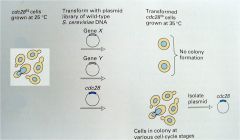
You can't knock down cell cycle genes, because organism might die. Can use temperature sensitive mutated organisms, where the cell cycle stops at a different temperature. Use Saccharomyces cerevisiae (yeast)- can see what phase it's in because it buds.
|
|
|
What was found in the S. cerevisiae yeast cell cycle experiment?
|
(Paul Nurse) Cdc28ts (temperature sensitive mutant) cells grow normally at 25degreesC, but at 35 degrees C there is no colony formation. To see what genes are required in cell cycle, see what gene rescues these mutants (genetic complimentation experiment). Transform with plasmid library of wild-type S. cerevisiae cDNA to find which gene.
|
|
|
Fission yeast (S. pombe) cell division cycle
|

SImilar cell cycle to mammalian cells, same regulatory genes. They're small sized in G1 and large in G2- easy to see what phase they're in. Mutants can be rescued by human cDNA-- cell cycle is conserved from yeast to humans.
|
|
|
How were cylcin A & B discovered?
|
By Tim Hunt- studied clam eggs because they divide in synchrony- isolated them at different cell cycle stages and looked at their protein expression with protein gels- found 2 proteins that cycle during the cell cycle
|
|
|
Discovery of Maturation Promotion Factor (MPF)
|
Study of maturation of Zenopus oocytes- adding progesterone triggers meiosis, then egg is arrested in in meiosis ii metaphase until it's fertilized. When you transfer the cytoplasm of the arrested egg into the cytoplasm of another cell, the cell starts to undergo meiosis.
|
|
|
MPF activity profile during Xenopus oocyte maturation
|
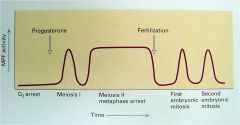
MPF activity cycles during meiosis development, it increases during meiosis I, decreases, then is high during meiosis ii until fertilization occurs.
|
|
|
What did Maller find out about MPF?
|
MPF contains two proteins (34kd and p45kd) and has kinase activity
|
|
|
How can you have cell-free mitotic cycling?
|
Put a cytoplasm from activated frog eggs, add ATP and nuclei from frog sperm.
|
|
|
(1) What happens to cell cycle when you add RNase treated extract?
(2)What happens when you add back nondegradable cyclin B mRNA? (3) What happens when you have RNase treated extract + wild type cyclin B mRNA? |
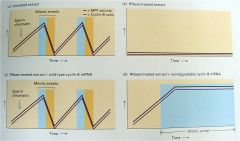
(1) Cell cycle stops
(2) Cell is at mitotic arrest because you need degradable cyclin B to get out of mitosis (3) Normal cell cycle; Therefore, cyclin B is necessary for mitosis cycles and for MPF activity in Xenopus egg extracts |
|
|
What is the mechanism of mitotic cyclin distruction?
|

It's sequence specific- sequence for ubiquitination of cyclins. When cyclin is polyubiquitinated, proteasome degrades cyclin into peptides
|
|
|
What are the key subunits of Maturation promotion factor? (2)
|
(1) cyclin dependent kinase (Cdc2) which is always present in a cell
(2) mitotic cyclin which has a highly regulated half life |
|
|
Cdc2/MPF regulators (4)
|
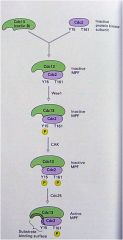
Cdc13/cyclin B ---> cdc2 (cdc2 needs to bind to cdc13 to activate)
wee1 ----| MPF (wee1 phosphorylates Y15 which is inhibitory) CAK ---> MPF (phosphorylates the active site) Cdc25 ---> MPF (takes off the inhibitory P that wee1 put on) |
|
|
Mammalian cell cycle regulators
|
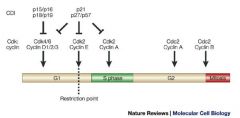
Cylcin A & B- Mitotic cyclins;
More complicated |
|
|
How does p27 inhibit Cyclin A/cdk2?
|
p27 touches both ends- cyclin A & cdk2- fixes it's N terminus in catalytic cleft preventing access of ATP to the kinase. highly stable conformation and inactive.
|
|
|
How does p19 inhibit cdk4/9?
|
They bind to the periphery of cd6 subunit and freeze it in inactive formation so that it can not bind to it's cyclin subunit (cyclin A)
|
|
|
What phase of the cell cycle are growth factors required?
|
If you take out growth factors before the restriction point, cells go back to G1 phase. If you take out growth factor after, it keeps going into S phase. This study was done by taking out growth factors at different times in the cell cycle and see if they go back to G1 or continue.
|
|
|
Expression profile of cyclins during cell cycle progression
|

(1) In G0 there are high amounts of p27 and p21 inhibitors. (2) Add mitogens, this decreases p27 activity. Cyclin D is the first cyclin is induced, which connects mitogens and cell cycle regulatory system
(3) Cyclin E is synthesized, the A and B are induced which drive cell movement into M phase, and then are destroyed for cells to exit M phase. |
|
|
Experiment to determine the role of cyclin D during S phase entry
|
anti-cyclin D antibodies were injected at different times after growth factors were injected into the cell and they found that cyclin D is the first necessary component for mitogen signaling
|
|
|
When is Myc active?
|
in G1--Myc in addition to growth factors induces transition from G1 to S phase of the cell cycles. Myc is an oncogene which promotes cell division.
|
|
|
How is CycE/Cdk2 activated by Myc?
|
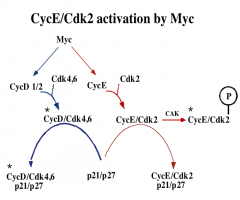
Myc first activate the synthesis CycD and Cdk4/6 which bind together to activate. As soon as they are active, the first thing they do is inhibit the inhibitors (p21/p27) by binding to them, which actually does not inhibit CycD/Cdk4/6. This prevents p21/p27 from inhibiting CycE/Cdk2, which is why Myc activates the synthesis of CycE and Cdk2 second.
|

